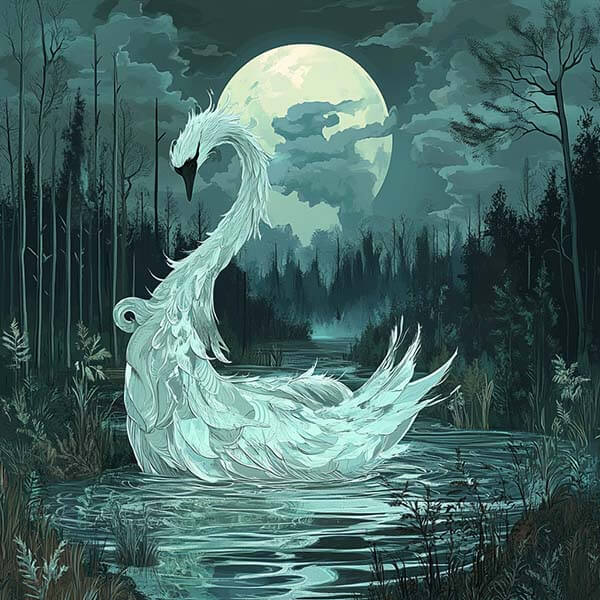
Tuonela
Realm in the Kalevala
The Land of the Dead (Underworld)
Karelian / Finnish Mythology
Tuonela, meaning “the abode,” is where the dead rest in the Kalevala. The ruler of the underworld is Tuoni, the god of death, accompanied by his wife, Tuonetar. Unlike other beliefs, judgment and punishment do not exist in Tuonela. Instead, it is a place where the dead rest in stillness and silence.
The River of Tuoni separates the land of the living from the land of the dead. Those who enter the land of the dead can only leave with Tuoni’s permission. The lands are dark and foreboding places that symbolize life and death cycles.
Tuonela is located in the northernmost part of the world, separated by the River of Tuoni. Once inhabitants enter, Tuonetar offers them a memory-erasing beer that allows them to forget their living memories.
Tuonela’s Geography
The geography of Tuonela is described as gloomy, dark, misty, and shadowy. The land has a somber and uninviting air governed by the laws of the Tuoni. It is a place to explore spirituality and a place of trials for the heroes of Kalevala.
The River of Tuoni – The River of Tuoni is a dark and murky river that separates the land of the living from the land of the dead. The Swan of Tuonela, or the black swan, guards the river. The haunting song of the Swan of Tuonela is said to be fatal yet eerily beautiful.
The Hall of Tuoni – The Hall of Tuoni is where the god of death and his wife, Tuonetar, rule the land of the dead. It is a dark, uninviting, cold, and barren hallway where the dead linger.
Stillness and desolation surround the Hall of Tuoni as the spirits of the dead reside in quiet stillness. The concept of the afterlife for Finns emphasizes rest instead of punishment and judgment.
Dark Forests – Mist and silence fill the forests of Tuonela. These dark forests surround most of the landscape, creating an eerie and quiet ambiance. Spirits and other supernatural forces are said to inhabit these forests.
Shadowy Plains – Dark, misty plains make up the center of Tuonela, where the Hall of Tuoni resides. The dead wander these plains, and the lack of vegetation symbolizes the emptiness and repose of the afterlife.
Stagnant Marshlands – Still and stagnant marshlands make up the landscape past the River of Tuoni. The stillness of these waters symbolizes the unchanging essence of the afterlife and provides challenges for the heroes to cross.
Perpetual Twilight – Darkness and muted colors make up the ambiance of Tuonela. The lack of sunlight symbolizes stagnation, as life cannot flourish in the lands of the dead.
Role of Tuonela
Tuonela also plays an essential role in the quests of Väinämöinen and Lemminkäinen. Both of these heroes must overcome challenges in the lands of the dead.
Lemminkäinen’s Death
Lemminkäinen sets out on a quest to kill the Swan of Tuonela for Louhi. In exchange, he hopes to win her daughter, the Maiden of Pohjola, hand in marriage. However, his quest is cut short when a blind shepherd kills him with a poisonous reed. Subsequently, his body is dismembered and cast into the River of Tuonela.
His mother becomes worried when the hero fails to return home. She embarks on a journey to find her missing son. Eventually, she finds his dismembered body and sews Lemminkäinen back together. But this fails to revive the hero. Ultimately, she sends a bee to retrieve sacred honey in a thimble, which is provided by Ukko. This divine honey finally restores the life of Lemminkäinen.
Väinämöinen’s Search for Words
Väinämöinen seeks out to find forbidden knowledge to cast a powerful spell which is comprised of three magical words. Even though his magic is powerful, the hero is missing a word to complete his spell. Consequently, he decides to venture to Tuonela to acquire this missing word.
Before Ilmarinen’s wedding, Väinämöinen seeks to learn a powerful blessing spell. At a loss, the only suitable place to learn this knowledge is the underworld. He crosses the River of Tuonela, and despite the warnings from the ferrywoman, Tuonen tytti (Tuoni’s girl), Väinämöinen agrees to cross into the underworld.
The hero eventually encounters the giant Antero Vipunen. He is swallowed by the giant, causing pain in Vipunen’s belly. After a battle of words and Vipunen’s failure to curse Väinämöinen out of his belly, the giant sings the missing words needed for the spell.
Those who enter Tuonela are forbidden to leave. Nevertheless, Väinämöinen’s wit and magic allow him to find a way to leave the land of the dead. With a large chain net in his way, the hero transforms into a snake to pass through and wade across the river back to the land of the living.
Inhabitants of Tuonela
Tuonela is a place where the dead go to reside in silence and peace. However, its inhabitants also include demons and other spirits.
- Tuoni: The god of the dead
- Tuonetar: Tuoni’s Wife
- Tuonen Tyttäret: Daughters of Tuoni and Tuonetar
- The Swan of Tuonela
- The Souls of the Dead
- Malevolent Spirits
Symbolism of the Underworld
Tuonela symbolizes the cycle of life and death and the ideal afterlife for the Finns, one of peace and stillness. It represents eternity, stillness, mystery, and a final resting place in the transition to death. Tuonela also emphasizes the duality of nature, life, death, and the boundary between worlds.
Tuonela also represents a mystical place that tests the heroes’ valor and courage. It symbolizes personal growth through confronting mortality. Unlike the underworld in other mythology, Tuonela is not a place where the dead receive punishment. It is simply a place where the souls of the dead can rest in stillness and quiet peace.
